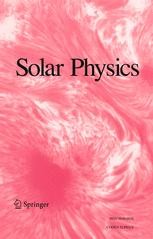Solar Physics Editor's Choice: Flux Accretion and Coronal Mass Ejection Dynamics
 Welsch, B.T., Flux Accretion and Coronal Mass Ejection Dynamics, Sol Phys (2018) 293: 113. https://doi.org/10.1007/s11207-018-1329-y
Welsch, B.T., Flux Accretion and Coronal Mass Ejection Dynamics, Sol Phys (2018) 293: 113. https://doi.org/10.1007/s11207-018-1329-y
Editor's Choice (Research Article)
First Online: 23 July 2018
"This paper contains a very novel approach which will have important implications in the domain. The author analyzes analytically the implications of magnetic reconnection behind an erupting flux rope. This approach is original and it provides a complementary view to existing models. The paper is well organized and the claims are well sustained by order of magnitude analytical arguments."
Abstract:
Coronal mass ejections (CMEs) are the primary drivers of severe space weather disturbances in the heliosphere. Models of CME dynamics have been proposed that do not fully include the effects of magnetic reconnection on the forces driving the ejection. Both observations and numerical modeling, however, suggest that reconnection likely plays a major role in most, if not all, fast CMEs. Here, we theoretically investigate the accretion of magnetic flux onto a rising ejection by reconnection involving the ejection’s background field. This reconnection alters the magnetic structure of the ejection and its environment, thereby modifying the forces acting upon the ejection, generically increasing its upward acceleration. The modified forces, in turn, can more strongly drive the reconnection. This feedback process acts, effectively, as an instability, which we refer to as a reconnective instability. Our analysis implies that CME models that neglect the effects of reconnection cannot accurately describe observed CME dynamics. Our ultimate aim is to understand changes in CME acceleration in terms of observable properties of magnetic reconnection, such as the amount of reconnected flux. This flux can be estimated from observations of flare ribbons and photospheric magnetic fields.
The author:
Brian T. Welsch is Assistant Professor of Physics in the Department of Natural & Applied Sciences at the University of Wisconsin - Green Bay, and Associate Research Physicist in the Space Sciences Laboratory at the University of California, Berkeley.
His research interests are the evolution of solar magnetic fields, particularly the transport of magnetic energy and magnetic helicity from the solar interior into the corona; photospheric flows associated with these processes; the roles of magnetic energy, magnetic helicity, and magnetic structure in flares and coronal mass ejections (CMEs); and the physics of magnetic reconnection, flares, and CMEs.
Solar Physics Editor's Choice:
In each volume of Solar Physics a few papers are marked as “Editor’s Choice”. The primary criteria is original, high quality research that is of wide interest within the community.
